Man’s best friend has a pretty unique set of chompers that differ wildly from human teeth. Dogs are notorious for not allowing their humans to see, touch, or brush their full set of pearly whites, so charts like the one below remain helpful in understanding what sort of structure their mouth has. The anatomy of dogs’ teeth explains how their four types of teeth have aided them in eating, hunting, grooming, and more.
Keep reading to decode the mystery of your dog’s teeth, including the types of teeth they have, what they’re used for, and how to keep them clean.
How to Use and Read a Canine Dental Chart
You don’t have to be a veterinarian to understand a chart of your dog’s teeth. Thanks to color-coding and labeling, you can learn all you need to know by interpreting the chart below with some handy additional information.

Dogs have more teeth than humans, but we both have the same types of teeth: incisors, canines, premolars, and molars.
©Rainer Lesniewski/Shutterstock.com
Incisor Teeth
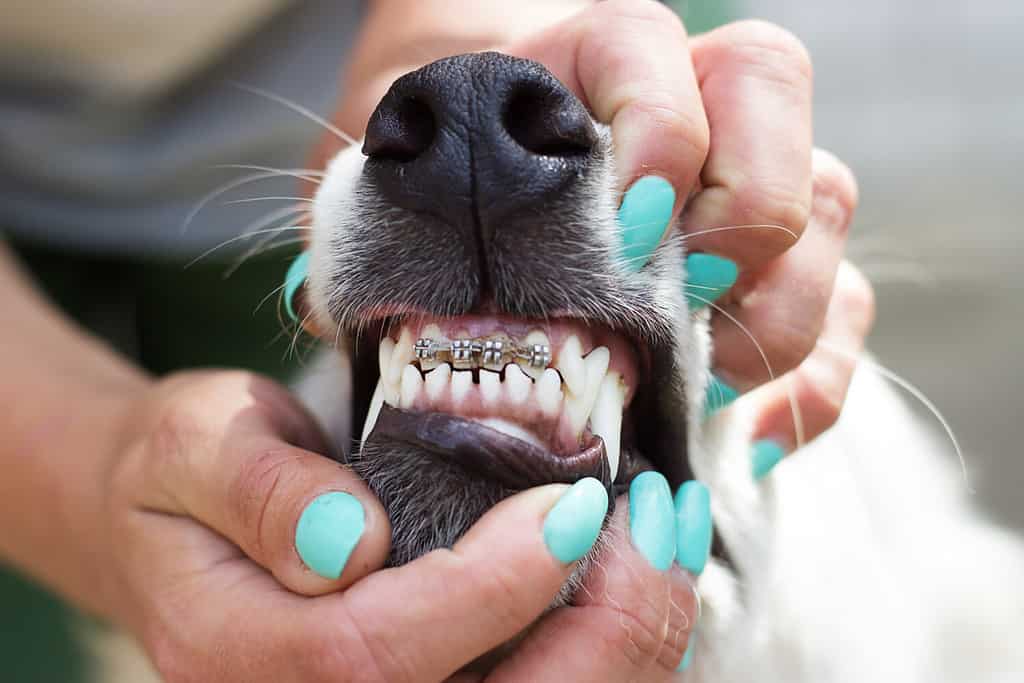
The incisor teeth can have braces on them to handle severe orthodontic problems.
©Happy monkey/Shutterstock.com
Labeled in blue, the incisor teeth on a dog are located at the front of their mouth. Adult dogs have 12 incisor teeth; six on the top and six on the bottom. These teeth are small and are labeled 11, 12, and 13 on both sides and levels of the dog’s teeth chart.
Because these teeth are small, they’re able to bite something precisely. That means if your dog wants to pick something up or out of their skin carefully, they’ll use their incisor teeth.
Your dog uses its incisor teeth to groom itself (like itch scratch or remove fleas) and eat. Generations ago, the evolution of a dog’s teeth created incisors to scrape meat from a bone. These teeth have a “shovel-like” shape and prime location to be used as a scraper or digger. You’ll also notice your dog using their incisor teeth to pick a tick out of their fur or gently grasp a treat from outstretched hands.
Canine Teeth
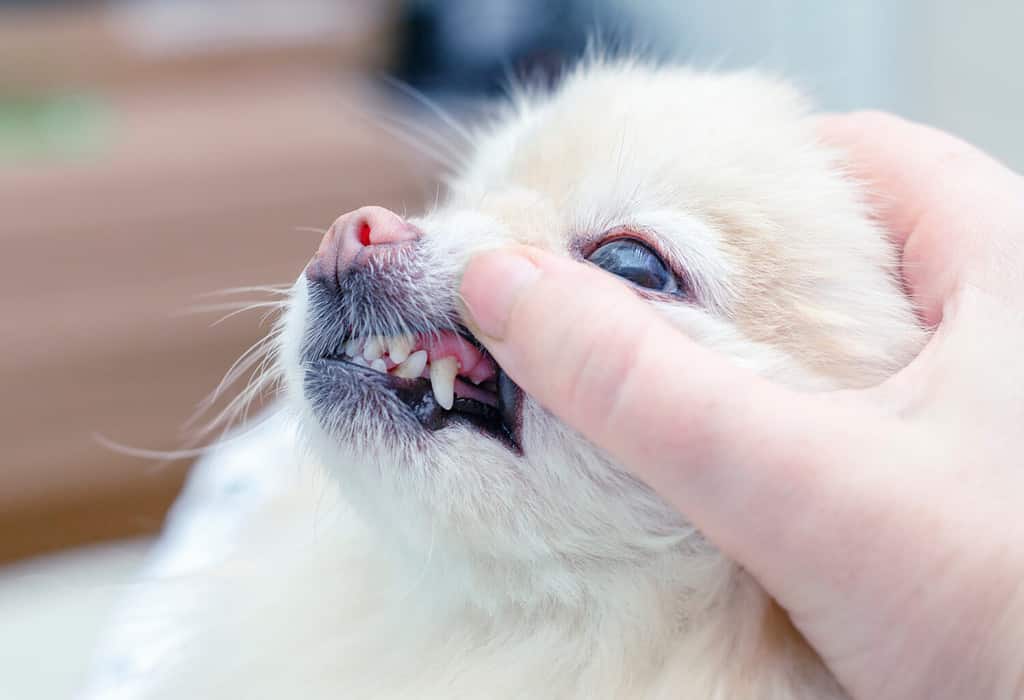
Canine teeth will help a dog latch onto or tear into a piece of meat, toy, or intruder.
©Ivan4es/Shutterstock.com
Dogs only have four canine teeth. Colored green on the canine dental chart and labeled “C1,” canine teeth are one of a dog’s most important tools. They are long and pointed, closely resembling the popularized version of a “fang.” Canine teeth always grow behind the incisor teeth. There is one canine tooth bordering each side of the incisor teeth, two on the top row and two on the bottom row.
Similar to the incisor’s first use, dogs grew their canine teeth to get the meat off of a bone. Instead of scraping, canine teeth are bigger and stronger so they’re more commonly used to tear meat off. Today, dogs often use their canine teeth as a lock on whatever they have in their mouth. Canine teeth create a vice on bones, chew toys, or other playtime things to keep them locked in their grip. They can get a workout during tug-of-war, but it’s important in puppyhood to not play too hard, or you may damage your dog’s canines. Canine teeth also have the ability to puncture holes.
Premolar Teeth
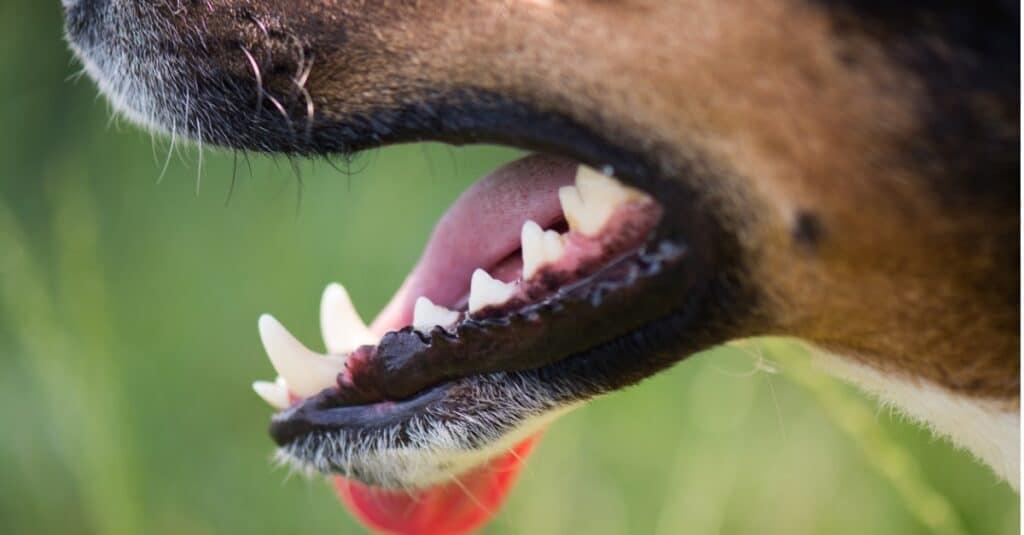
A dog’s mouth has more premolars than any other type of tooth.
©iStock.com/betyarlaca
Colored in orange on the canine dental chart, premolar teeth are of differing sizes but have a common sharp edge. Adult dogs have 16 premolar teeth: eight on the top and eight on the bottom. There are four on each side of their mouths, labeled as P1, P2, P3, and P4 for “premolar 1,” “premolar 2,” and so forth. Premolar teeth are located behind the canine teeth. Often if a dog chews something out of the side of their mouth, they’re using their premolars.
Premolar teeth have sharp, serrated edges to serve as a shredding tool. When dogs hunted, these teeth used their strength to chew, rip, and shred. While the incisors scraped food off a bone and the canine tore large pieces, the premolars of a dog’s dental anatomy shredded whatever made it into the mouth into tiny bits so the dog could digest it. Most dogs use these, and their molars, to eat dry food owners now provide. Overall, the premolar teeth function and primary chewing teeth.
Molar Teeth
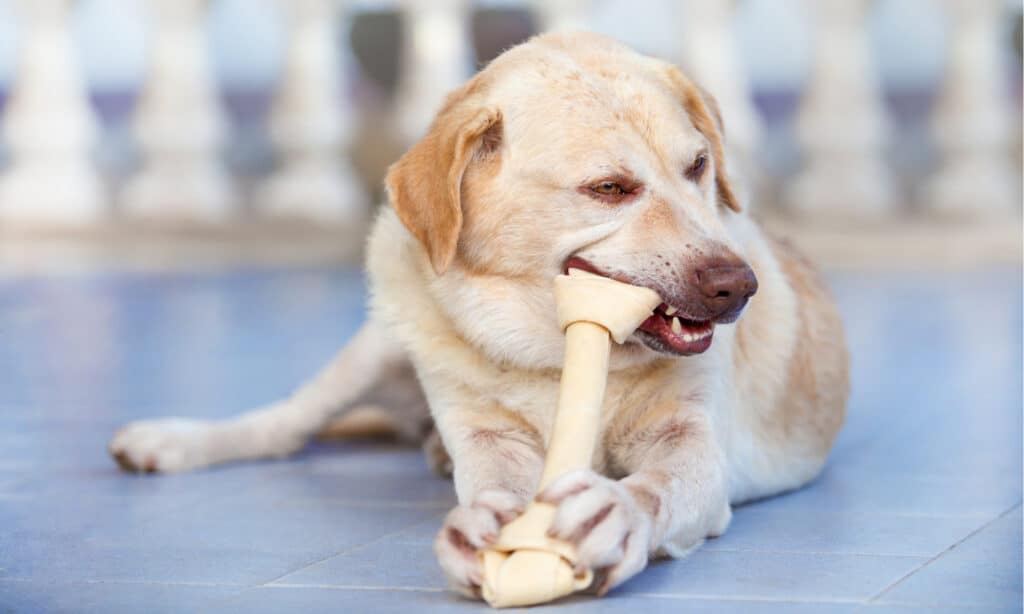
Molars in a dog’s mouth handle the job of hard or tough chewing.
©MaxShutter/Shutterstock.com
Finally, the gray teeth located in the center of the image are the molars. Labeled as M1 to M3 for “molar 1,” “molar 2,” and “molar 3,” you’ll see that the upper jaw of a dog only has four molars while the bottom has six. The upper jaw has two M1 and M2 molars while the lower jaw has two M1, M2, and M3 molars. Like premolars, these teeth are of varying size with sharp edges — though they may look flat based on what you can see from a quick glance. They’re located at the very back of a dog’s mouth, at the hinge of their jaw.
Molars have deep roots in a dog’s mouth, making them the go-to tooth to chew up anything hard. If you don’t hydrate your dog’s food, their molars will work with their premolars to chew and swallow dry kibble. Dogs also use their molars for grinding.
How Many Teeth Do Dogs Have?
Adult dogs have 42 permanent teeth while puppies only have 28 teeth. As puppies, dogs don’t develop their molars. They also develop four less premolar teeth. Why? Because the teeth puppies have are called “milk teeth” to feed from their mother. They don’t need to bite or grind hard yet, which is why their strong molars come in later.
Here’s a handy table of the teeth your dog will have when they’re younger and older.
| Type of Tooth | Number as a Puppy | Number as an Adult |
|---|---|---|
| Incisor | 12 | 12 |
| Canine | Four | Four |
| Premolar | 12 | 16 |
| Molar | 0 | 10 |
Common Dog Dental Issues
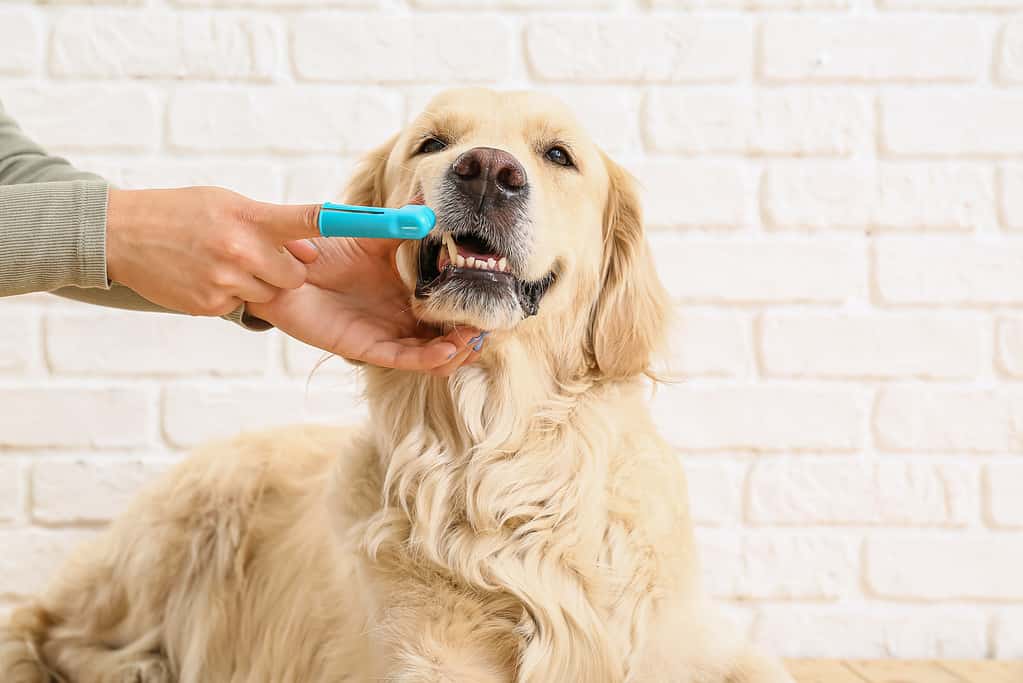
Brushing your pet’s teeth is the best way to prevent tooth and gum diseases in your dog.
©Pixel-Shot/Shutterstock.com
Like humans, dogs have a variety of dental issues. It’s important to also note that when an adult dog loses their permanent tooth, it won’t grow back.
Periodontitis
Ranked as the number one cause of tooth loss in pets (for both dogs and cats), periodontitis is a gum disease that happens when plaque and tartar trigger significant inflammation. Usually, this problem affects the canine teeth more than the other types and can spread to your dog’s bone. If detected early, you and your vet can reverse periodontitis.
Gingivitis
Not as serious as periodontitis, gingivitis describes simply the inflammation of gums in response to a plaque or tartar buildup.
Fractured Tooth
It’s not uncommon for your dog to have his or her mouth full of things all the time. Dogs tend to be orally fixated creatures, meaning many things are coming in and out of their mouth. During that exchange, accidents will happen and your dog may chip or fracture a tooth. Even if the fracture or chip is small, your dog will most likely stop or limit their eating because of the pain. Going to a vet will let you know if your dog will need surgery to fix it.
Oral Tumor
These tumors in dogs can be either benign or malignant, just like tumors in humans. Oral melanoma, an aggressive form of cancer that affects dogs, starts with a tumor inside your dog’s mouth. It needs to be removed immediately to avoid the cancer spreading to other parts of the body.
Complications of Deciduous Teeth
The deciduous teeth of a dog, also known as their puppy teeth or milk teeth, can stick around in their mouth even after they are supposed to fall out. When they do, they force the permanent teeth to malposition in an awkward place that may cause an over- or underbite or regularly come into contact with soft tissue in the mouth it’s not normally supposed to.
If your pup still has its deciduous teeth as an adult, there’s a greater risk for tooth decay, plaque buildup, and dental interlock.
Best Practices to Care for Your Dog’s Teeth
Because you know the layout of your dog’s teeth — thanks to the handy canine dental chart above — you have the ability to fully understand and care for your dog’s dental needs. Some of the best practices to keep your canine’s teeth healthy include:
Brush Your Dog’s Teeth
If your dog will let you, brushing their teeth is the best way to keep their teeth clean and healthy. Don’t use human toothpaste — use the canine-specific brands that taste like chicken or peanut butter. Then, get your pup used to your fingers and hands in their mouth as you clean each tooth, front and back, to prevent plaque buildup.
Use Dental Treats Regularly
The market is saturated with dental dog treats, and thank goodness for it! While more expensive than regular treats, these are specially designed with ingredients to freshen breath, kill bacteria, and clean your dog’s mouth.
Opt for Tooth Wipes
If treats and brushing won’t work, attempt to use tooth wipes. They have the same use as a brush but have a much less frightening sensation for dogs. The wipes intend to scrape plaque off of the surface of their teeth but won’t get into the nooks and crannies brushes can reach.
Schedule a Professional Cleaning
If you’ve tried everything and your dog just won’t let your hands near their mouth, leave it to the professionals. They’re skilled in cleaning dogs’ teeth and will ensure they don’t hurt or scare your pup.
Add Dental Powder to a Meal
Some companies create a flavored powder that goes into food consistently. It features a probiotic that freshens breath, kills bacteria, and prevents plaque buildup.
Think About a Water Additive
Just like fluoride for humans, water additives are tasteless while helping your dog’s mouth kill bacteria. Bonus: it makes your dog’s mouth smell better, too!
Consider Dental Food
Companies now make special food for dental health. Some of the smaller or brachycephalic breeds (like pugs, chihuahuas, terriers, and Frenchies) who remain resistant to other forms of dental health but are at high risk of periodontal disease may benefit from this method. These few types of food have been clinically proven to reduce the risk of dental disease.
Keep an Eye on Your Dog’s Mouth
The easiest way to care for your dog’s teeth is to simply check up on them every once and a while. Not only does touching your dog’s lips and teeth acclimate them more to the sensation, but it also gives you a heads-up if something seems amiss. That way, a minor problem doesn’t turn serious in the months or even years between vet visits.
It’s difficult to settle dogs enough to make them comfortable with dental cleanings. That’s why some vets need to put dogs to sleep to safely clean their teeth! If you’d like your dog to have a stress-free relationship with dental cleanings, start them early. Put your fingers or a brush in their mouth to acclimate them to the feeling. Make sure to positively reinforce them when they handle the situation well. Soon enough, they’ll learn that they’ll get treats after the ordeal — even if they are uncomfortable.
Paging Doctor Dog!
Now that you know how to decode a canine dental chart, you can confidently talk to your vet about any issues you notice with your pup’s mouth. It might be a simple concern about the state of their teeth, or your adult dog might have lost a tooth. Either way, now that you know which tooth is which — and their functions — you can keep your dog’s teeth as white and well taken care of as yours!
The photo featured at the top of this post is © PolyPloiid/Shutterstock.com
Ready to discover the top 10 cutest dog breeds in the entire world?
How about the fastest dogs, the largest dogs and those that are -- quite frankly -- just the kindest dogs on the planet? Each day, AZ Animals sends out lists just like this to our thousands of email subscribers. And the best part? It's FREE. Join today by entering your email below.
Thank you for reading! Have some feedback for us? Contact the AZ Animals editorial team.







